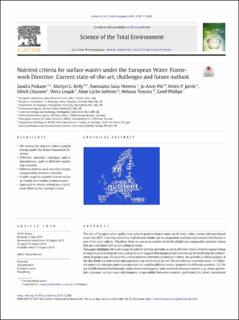| dc.description.abstract | The aim of European water policy is to achieve good ecological status in all rivers, lakes, coastal and transitional waters by 2027. Currently, more than half of water bodies are in a degraded condition and nutrient enrichment is one of the main culprits. Therefore, there is a pressing need to establish reliable and comparable nutrient criteria that are consistent with good ecological status. This paper highlights the wide range of nutrient criteria currently in use by Member States of the European Union to support good ecological status and goes on to suggest that inappropriate criteria may be hindering the achievement of good status. Along with a comprehensive overview of nutrient criteria, we provide a critical analysis of the threshold concentrations and approaches by which these are set. We identify four essential issues: (1) Different nutrients (nitrogen and/or phosphorus) are used for different water categories in different countries. (2) The use of different nutrient fractions (total, dissolved inorganic) and statistical summary metrics (e.g., mean, percentiles, seasonal, annual) currently hampers comparability between countries, particularly for rivers, transitional and coastal waters. (3) Wide ranges in nutrient threshold values within shared water body types, in some cases showing more than a 10-fold difference in concentrations. (4) Different approaches used to set threshold nutrient concentrations to define the boundary between “good” and “moderate” ecological status. Expert judgement-based methods resulted in significantly higher (less stringent) good-moderate threshold values compared with data-driven approaches, highlighting the importance of consistent and rigorous approaches to criteria setting. We suggest that further development of nutrient criteria should be based on relationships between ecological status and nutrient concentrations, taking into account the need for comparability between different water categories, water body types within these categories, and countries. | en_US |

